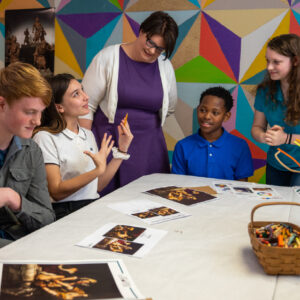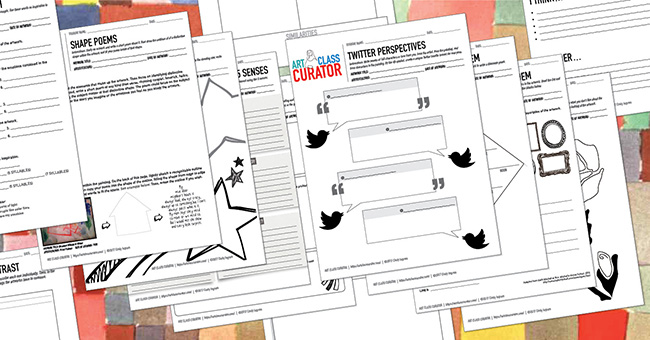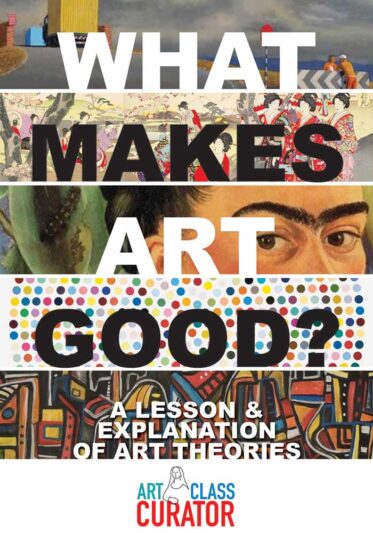Inside: In this Kehinde Wiley art lesson, have students compare and contrast the Kehinde Wiley stained class, Mary Comforter of the Afflicted with an earlier depiction of the same subject. Use the art appreciation worksheet bundle to further your student’s exploration of this artwork.

I’m shining the spotlight on contemporary portrait painter Kehinde Wiley. His timely artworks are exciting to students and teachers alike as they confront the social and political issues that dominate many of today’s news cycles.

Get the Full Lesson!
This Lesson is in The Curated Connections Library!
Find the full lesson from this post along with hundreds of other art teaching resources and trainings in the Curated Connections Library. Click here for more information about how to join or enter your email below for a free SPARKworks lesson from the membership!

His powerful works are well-known in the art world and gained wider notoriety after being featured on the television series “Empire” in 2015. The recent decision to have Wiley paint Barack Obama’s official presidential portrait has no doubt cemented his popularity for decades to come.
Wiley is best known for painting young black people he encounters and placing them in revamped versions of traditional portraits. The glory, power and prestige once reserved only for white subjects is transferred to modern black men and women wearing everyday clothing. His paintings fuse the past and present in ways that force us to confront our notions of wealth, importance, race, and gender.

Wiley’s bold backgrounds often feature flowers and greenery or intricate baroque patterns that clash with the photo-like realism of his subjects. Many of his portraits are larger than life and stand over six feet tall. Looking at Wiley’s portraits, it’s impossible to miss the gaze of his subjects. They make eye contact and hold the viewer in place, towering over and transfixing them until they ponder the decisions the artist made and the meaning he hoped to convey.
There is a political and racial context behind everything that I do. Not always because I design it that way, or because I want it that way, but rather because it’s just the way people look at the work of an African-American artist in this country.
-Kehinde Wiley
Race is an inescapable element of Wiley’s work. We experience it in light of the culture that surrounds us. We connect the meaning of the art to his race and the race of his subjects. How would our perspective change if he or the people in his paintings were another race? Regardless of Wiley’s intentions, his work speaks volumes about us and our society. This topic alone can provoke hours of conversation.
Kehinde Wiley Art Lesson

In the artwork above, Wiley uses religious iconography and modifies it to fit today. He replaced Mary, a symbol of comfort, protection, and virtue in Christianity, with a black man holding a child. The juxtaposition of these artworks is sure to spark curiosity in your students and invite a lively discussion into your classroom.
Discussion Questions
- What’s going on here? What do you see that makes you say that?
- Who is this man? What is he doing?
- Explain the expression on his face. What do you think he is thinking?
- What symbols do you notice in this artwork? (Note the Illuminati eye, shackles, blindfold, and the feather headdress.) What could these things symbolize?
- What does afflicted mean? How do you see “Afflicted” in this artwork?
- Examine each character in the artwork (or use one of the activities below). Who are they? What do they think/feel?
Activity Suggestions

- Compare and contrast the two versions of Mary, Comforter of the Afflicted. Ask students why Wiley made the choices he made. You may use the Compare and Contrast worksheet from the free art worksheet bundle.
- Use either the “I Am” Character Poem worksheet or the Character Analysis worksheet from the Art Appreciation Printable Worksheet Bundle or Resource Library. Assign each student (or have them choose) one character from the painting. Have each student study their character to determine what they are all about, how they feel, etc.

Free Worksheets!
Art Appreciation Worksheets
In this free bundle of art worksheets, you receive six ready-to-use art worksheets with looking activities designed to work with almost any work of art.
Classroom Extensions
- Young Students: Have students create portraits with a patterned background. See Devon Calvert’s lesson for an explanation.
- Older students: Have students create an updated, contemporary version of an older artwork.





I looked through the presidential portraits (and bookmarked the source!) and I found that I am really drawn to the surprisingly modern feel of the Buchanan portrait, with the all-black background and only his hands and bust showing. I also love the emotion and the nod to impressionism in the Kennedy portrait. I want to do some more research on some of the portraits. I know the props that are painted with the presidents usually have special significance.
Yeah I love the Kennedy one too! It’s such a good connection to the assassination as well. I think many of the portraits are so fun to look at!
Who is the original artist of the 1st stained glass image? What year was it created?
Thank you,
Hi Juliette,
The original stained glass artwork is from Cathedral of the Assumption of Trois-Rivières, which was built in the 1850s. There are many, many artworks in that style with a similar title, however.
Hope that helps!
Careful with the Napoleon one. It has sperm in the background.
The background is also infused with tiny paintings of sperm—Wiley’s way of poking fun at the highly charged masculinity and propagation of gendered identity that are involved in the Western tradition of portraiture. This particular subgenre of portraiture—the equestrian portrait—is particularly infused with the lineage of male power. From classical Rome to post-revolutionary France, political and military leaders on horseback have evoked and perpetuated social norms of masculine might and control (for example, this equestrian portrait of the Roman Emperor Marcus Aurelius).
Thank you for this insight!